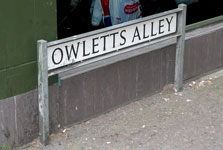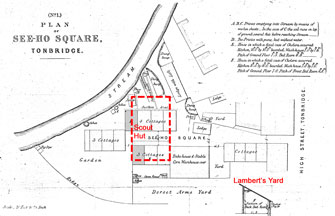1849 and 1854: Cholera comes to Tonbridge
In the nineteenth century Tonbridge could be an unhealthy place in which to
live. A number of diseases, such as typhoid, were endemic and there were
periodic epidemics of smallpox and cholera. The latter was particularly feared
because of its sudden appearance, unpleasant symptoms and high death rate. John
Snow did not publish his research showing that cholera could be transmitted
through drinking water until 1855 and before then there had been a number of
theories about its cause. However, some observers had noticed that it seemed to
thrive in unhygienic and over-crowed living conditions.
"cottages of a wretched description ..."
"bloated carcases of dogs were floating ..."
There were two particularly serious outbreaks of cholera in Tonbridge in 1849
and 1854, when thirty-nine deaths were recorded, and although this mortality was
relatively low compared to other areas it was sufficient to persuade a number of
local ratepayers that something needed to be done. An inquiry under the
provisions of the 1848 Public Health Act was, therefore, conducted by Alfred
Dickens into the sanitary condition of the town. His subsequent report gives us
a 'snapshot' of Tonbridge in 1854 and provides an insight into the living
conditions of its poorer inhabitants.

An alley (now called Owlett's Alley) led off the High Street to one of the worst slum areas,
abandoned after cholera struck in 1849. McDonald's now stands on some of the site.
Dickens was a conscientious Inspector. He walked round the town, making notes
in his memorandum book, and he also heard evidence from a number of residents. A
rather bleak picture emerged of a picturesque town with some dirty and squalid
areas. The inquiry highlighted problems resulting from the housing boom in the
1840s and 1850s when three farms virtually disappeared under the new streets of
south Tonbridge and in-filling behind the High Street resulted in substandard
houses being built in new courts and alleys. The condition of much of this new
housing was criticised by Dickens. Witness after witness described poor and unsanitary living conditions which
undoubtedly contributed to the Tonbridge death rate being higher than the
national average for similar locations.
There was also a clear difference
between Tonbridge north and south of the river with the death rate in the latter
being higher. A local doctor, John Gorham, was in no doubt about the reason for
the high death rate. He noted that Tonbridge south of the Big Bridge was
unhealthier than the northern part of the town because of 'its low level with
reference to the river Medway, accumulations of filth, dirty and offensive
privies and pig-sties, very imperfect drainage, and equally imperfect water
supply'.
"filthy, dirty and offensive privies and pigsties ..."
"pitiable child ... ill of fever ..."
Other witnesses also described the inadequate, or even non-existent
sanitation and poor housing south of the river. No wonder that Dickens concluded
that this area 'is scarcely a fit site at any time for the erection of
houses…Cottages of a wretched description are crowded, notwithstanding, on each
other in this district, and … are built with a disregard of decency and
convenience, and are charged in themselves with fresh causes of disease'.
Industrial pollution was also a problem and the report details complaints about
a fell yard, whose effluent drained into the Little Bridge stream, and a tallow
chandler’s melting establishment.
A water company had been founded in 1851 but at the time of the inquiry only
176 houses and 2 schools were connected. As there were 1,121 houses and cottages
in Tonbridge it is clear that the majority of the population drew their water
from one of the public pumps or from a private pump or well.
"cholera completely decimated the inhabitants ..."
"large, full and open cesspit ... vast amount of filth ..."
Although the report paints an unpleasant picture of the sanitation, drainage
and water supply in Tonbridge, principally in the part of the town south of the
Big Bridge,
Dickens believed that a number of things could be done to help. And conditions
did improve although it took time. Many Tonbridge ratepayers were not
immediately convinced that radical change was needed and the town had to wait
until 1870 until the newly formed Local Board began the work of improving
drainage and sanitation, widening the High Street and demolishing many of the
substandard properties criticised by Dickens.

See-Ho Square, off the High Street, was one of the town's slums.
Dwellings where people died of cholera are shaded in this plan from the Dickens
Report. The present-day Scout Hut and Lambert's Yard are shown in red.
(Map reproduced with the permission of Kent Libraries & Archives – Tonbridge
Library)
A number of plans form part of the Dickens report, two of which
illustrate how the area behind the High Street and below the Little Bridge used
to look. The first, reproduced here, is of Lambert's Yard and its continuation Seeho Square, where
the first fatal cases of cholera were reported in 1854. The second shows
Snelling's Row, now known as Owlett's Alley. Both plans show the density of housing
in these areas, the lack of privies and the close proximity to cottages of
nuisances such as a slaughter house, stables and an open dung heap. Nowadays Lambert's Yard and Owlett's Alley look very different from the
residential areas that they used to be. Their substandard housing has gone and
they are largely given over to commercial use. There is a McDonald's restaurant
on the corner of Owlett's Alley and the High Street and Tonbridge Country Market is
held on Friday mornings in the Scout Hut in Lambert’s Yard. The present day
visitor will find no trace of the former cottages and their inhabitants.
>Brief quotations from the Dickens Report appear on this page. If you are interested in finding out more about the state of Tonbridge in the
early 1850s the report is worth a read. A copy is held in the reference
section of Tonbridge Library.
>An article on cholera and typhoid fever in Kent is on the
Kent Archaeology website.
▲Top


